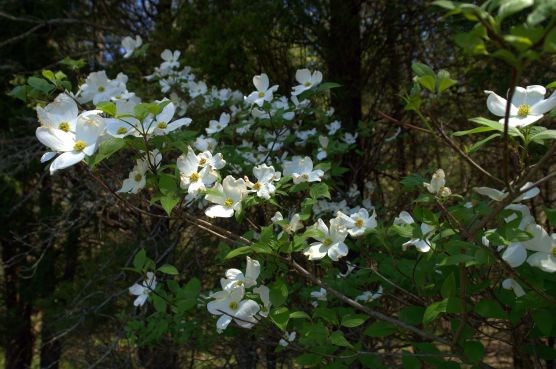|
With diverse terrain and underlying geology that affects the soil, Manassas National Battlefield Park is home to several distinct forest types. Some forests such as pine and cedar successional forests are relatively new, moving into areas that were farm fields decades ago. Other forests dominated by oak and hickory are common.

NPS Basic Oak-Hickory ForestWidespread in the park, basic oak-hickory forest covers 13% of the park's area on low ridges and rolling to flat uplands. White oak and pignut hickory are the dominant trees, along with northern red oak, post oak, and white ash. Smaller trees including the eastern redbud, eastern red cedar, flowering dogwood, eastern hophornbeam, slippery elm, hackberry, hornbeam and fringetree. These forests foster a the most diverse array of plants in the park, averaging 66 different types of plants per 400 m2.Oak-hickory forest grows in soils weathered from diabase, whereas the acidic oak-hickory forest is exclusively associated with soils weathered from siltstone. Thus, they are more common on the west side of the park. The dominant nut-bearing trees in oak-hickory forest provide an important food source for mammals such as squirrels. Acidic Oak-Hickory ForestSimilar to the basic oak-hickory forest, this community is drier and less diverse, with white oak dominating the canopy. Other trees are far less common, including black oak, northern red oak, mockernut hickory, red hickory, pignut hickory, and scarlet oak. Flowering dogwood, downy serviceberry, and deerberry are common shrubs. Mesic forestThis forest community is distinguished by two species not found elsewhere in the park: the chinkapin oak (Quercus muhlenbergii) and American bladdernut (Staphylea trifolia). This forest type is very rare in the park, confined to a short, steep slope (28º degrees) on an east-facing bluff bordering the Bull Run floodplain. Bitternut hickory, white ash, hackberry, northern red oak, and slippery elm are common here.Piedmont / Mountain Swamp ForestComprising less than 1% of the park's area, this forest type is found in seasonally-flooded sloughs and backswamps in the Bull Run floodplain, where floods typically occur every 1 to 3 years, and typically reach 8-10 inches, and in some places up to 20 inches. The flood waters typically drain by summer.Pin oak, swamp white oak and green ash dominate this forest canopy. with green ash exclusively occupying the wettest areas. Poison ivy is common, and vines may be seen climbing the trees here. The understory in this wet environment favors sedges, wood reed grass, and lizard's tail. Piedmont / Mountain Bottomland ForestCovering 5% of the park, these forests are found in areas of strongly acidic soils. Bitternut hickory, hackberry, green ash, black walnut, tulip poplar, Shumard oak, and American elm are common. While otherwise very similar to the Piedmont / mountain swamp forest, these lands drain better after floods and often do not contain pin oak or swamp white oak.Mountain bottomland forests are particularly vulnerable to invasive exotic plants such as garlic mustard, eulalia, chickweed, ground-ivy, and rough bluegrass, even in mature stands. White-tailed deer commonly browse bottomland forests. Cedar/Pine Successional ForestWidespread in the park, cedar and pine stands have sprung up in fields and clearings that were abandoned since the park's establishment. Virginia pine and eastern red cedar may grow in stands separately or mixed. Undergrowth in these forests is minimal, only covering 0-10% of the ground.Once pine/cedar stands mature after about 50 years, they are very vulnerable to being broken by wind and ice. However, this presents an opportunity for hardwoods such as oak and hickory to grow in their place. Park managers have used prescribed fire to control successional forests. The park's goal in doing so is to restore the landscape to a view more similar to what would have been seen in 1861-1862. For scientific names and more thorough species in each forest type, see more technical information about forest communities at Manassas National Battlefield Park. Species listSelect a Park:Select a Species Category (optional):
Search results will be displayed here.
|
Last updated: November 1, 2022
